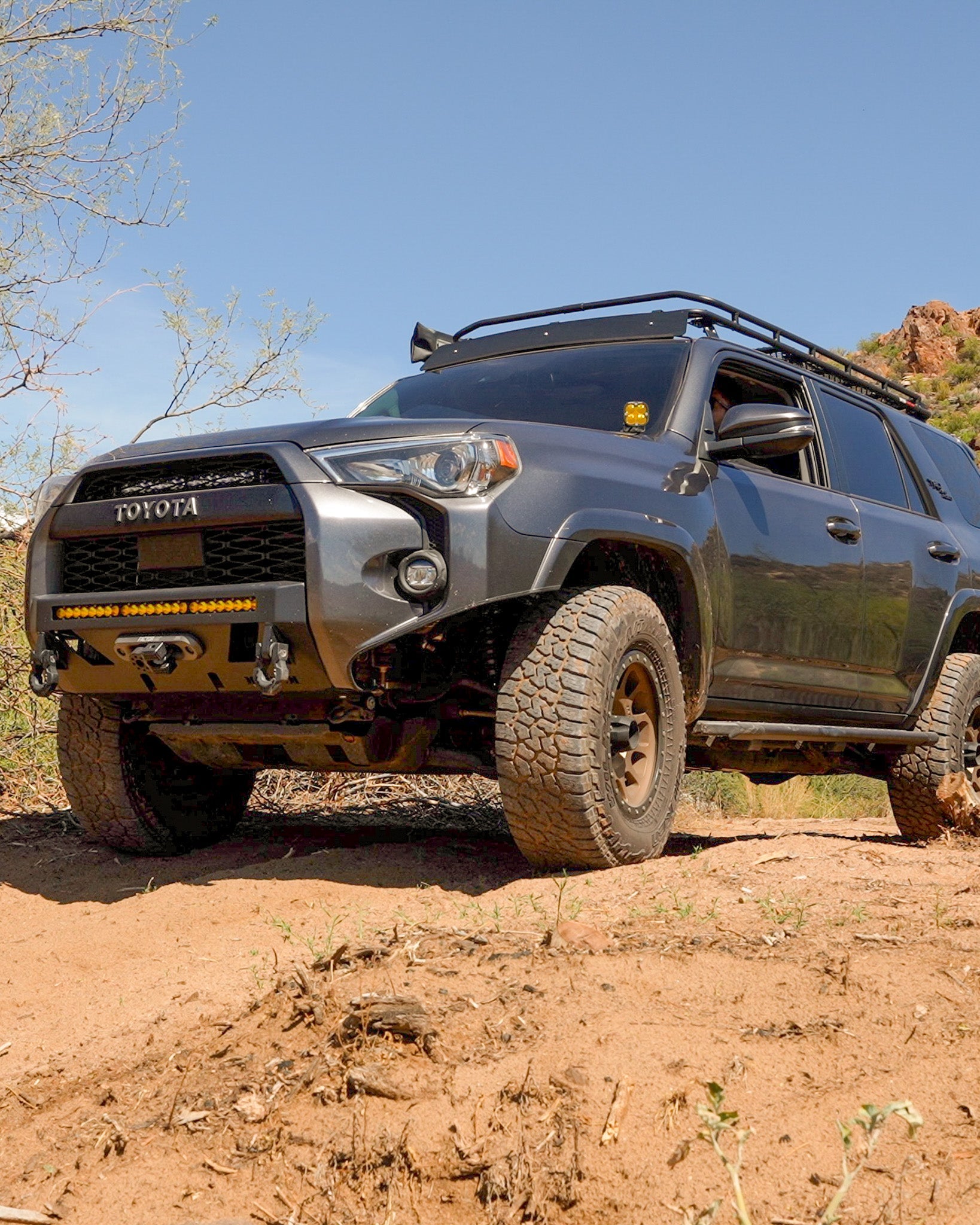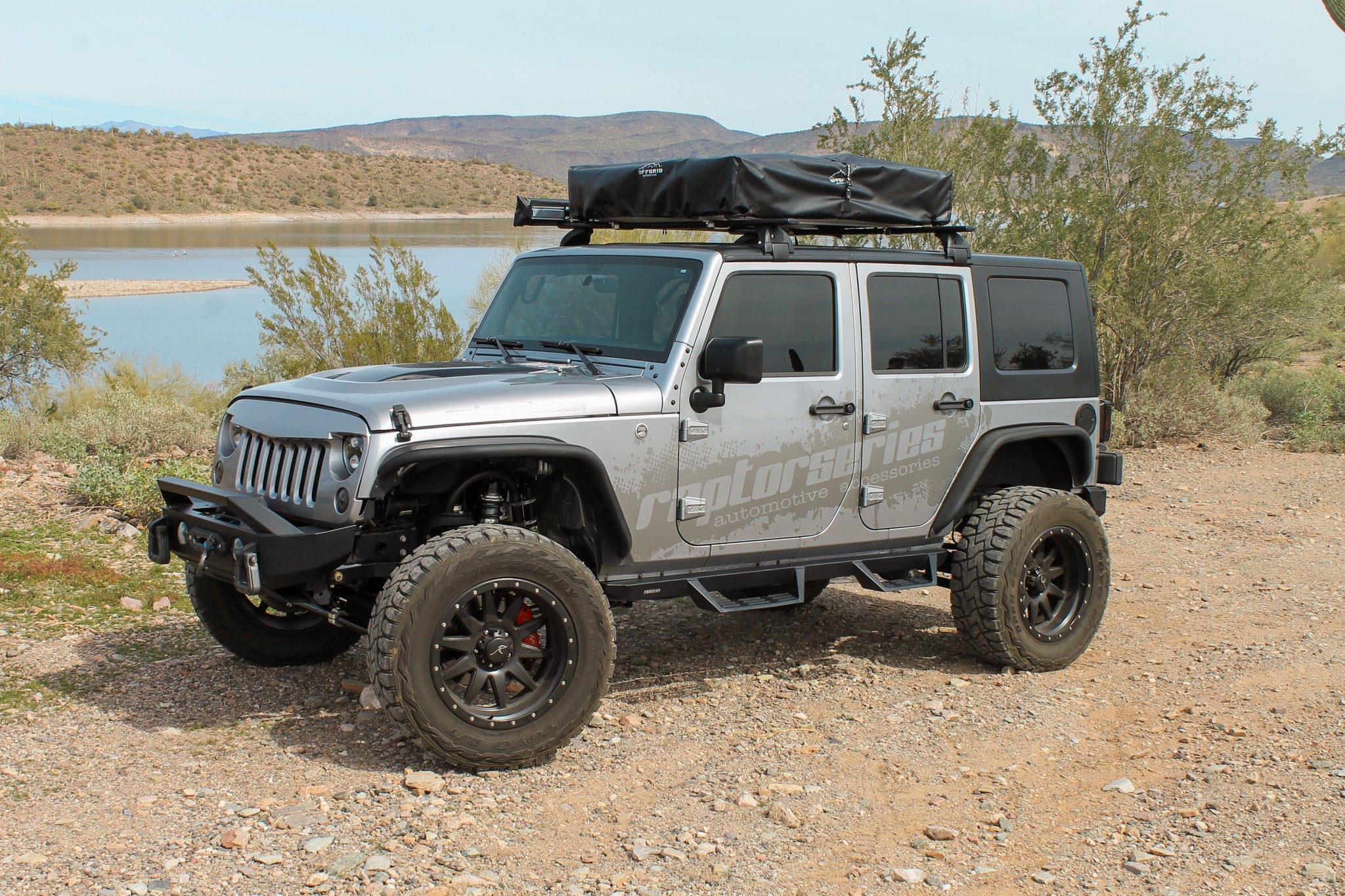Off-road bumpers provide essential protection, improve performance, and enhance functionality on the trails. Not to mention, they add character to your vehicle.
However, with so many options available, choosing the right one might seem overwhelming. Knowing what to look for, including the materials and construction, will help you make the best choice. Here’s what you need to know before upgrading your bumper.
Understanding Off-Road Bumpers
An off-road bumper is a crucial (and stylish) upgrade that offers increased durability, safety, and recovery capabilities.
Off-road bumpers come in different styles, each designed for specific conditions and purposes. While shopping, you may hear various terms used to describe them. Here’s a quick breakdown:
- Stubby Bumper: Compact and ideal for rock crawling, this offroad truck bumper maximizes tire exposure and articulation on tight trails.
- Mid-Width & Center Mount Bumpers: Extending slightly past the grille, these designs offer balanced protection and often include integrated winch mounts. Their low profile and easy install make them a popular choice.
- Full-Width Bumper: Covering the entire front end, this style delivers robust, all-around protection and is often finished with a durable powdered coating.
- Pre-Runner Bumper: Lightweight and designed for desert racing, these offroad ready bumpers optimize approach angles and clearance for high-speed offroading.
- Ranch/Brush Bumper: Focusing on complete front-end protection, these bumpers feature integrated bull bars and brush guards to shield your grille and headlights from branches and debris.
There are advantages to each of these styles depending on how and where you off-road. You should choose a design that balances performance with protection.
Are Off-Road Bumpers Legal?
Most off-road bumpers are street legal, but regulations vary by state. Some areas have restrictions on bumper height, width, and the presence of sharp edges. Many states also have specific laws regarding how high your bumper can be from the ground, which is something to consider if you've lifted your truck.
Check your local vehicle modification laws to ensure compliance before making any purchase to avoid fines.
Two Main Types of Offroad Bumpers and Their Benefits
Choosing a bumper style depends on your off-roading needs. Different types offer different levels of protection, clearance, and customization.
Front Bumpers for Off-Roading
- Full-Width Bumpers – Provide complete coverage across the front end, offering maximum protection.
- Stubby Bumpers – Offer better clearance and tire exposure for rock crawling.
- Pre-Runner Bumpers – Designed for high-speed off-roading, with skid plates and lightweight tubing.
Rear Offroad Bumpers
- Standard Rear Bumpers – Reinforced protection, often featuring tow hooks.
- High-Clearance Rear Bumpers – Angled designs to improve departure angles on steep terrain.
- Tire Carrier Bumpers – Ideal for oversized spare tires, freeing up cargo space.
Each bumper type serves a different function, so consider your driving style and off-road needs before deciding.

Key Factors to Consider When Choosing an Off-Road Bumper
A good offroad front bumper and offroad rear bumper can make all the difference when you're tackling rocky terrain, navigating muddy paths, or preparing for overlanding adventures.
Consider the following important factors when shopping for one.
1. Material and Thickness
The material of your bumper determines its strength, weight, and resistance to wear.
- Steel Bumpers – Extremely durable, best for hardcore off-roading, but heavier and may require suspension adjustments.
- Aluminum Bumpers – Lightweight, naturally resistant to rust, but slightly less impact-resistant than steel.
How thick should an off-road bumper be? For most heavy-duty off-road use, 3/16-inch to 1/4-inch steel plate provides excellent protection without adding excessive weight. Finding the right balance between strength and weight ensures your vehicle remains agile without compromising safety.
2. Build Quality and Construction
A high-quality bumper isn’t just about the material, it’s about how it’s built. Look for:
- Reinforced mounting points for added strength.
- Fully welded seams for maximum durability (avoid weak spot-welded bumpers).
- Powder coating or corrosion-resistant finishes to prevent rust.
A well-constructed bumper ensures longevity and performance, making it a worthwhile investment.
3. Engineering and Design
The best off-road bumpers are designed for both strength and functionality. Features to look for include:
- Proper welds and structural reinforcements to prevent bending under stress.
- High-clearance designs for improved approach and departure angles.
- Recovery points and winch mounts to assist in tough situations.
Choosing a bumper with a strong frame connection and smart engineering will provide better protection while maintaining your vehicle’s off-road capabilities.
4. Functionality and Customization
A bumper protects your vehicle and enhances your off-road capabilities. Consider:
- Winch compatibility – Essential for self-recovery on tough trails.
- D-ring mounts – Provide secure points for tow straps and shackles.
- Grille guards or brush bars – Extra protection for lights and the radiator.
- Integrated light mounts – Useful for adding LED bars or fog lights.
Think about the accessories you’ll need now and in the future. A bumper with built-in mounting options will allow for easier upgrades down the road.
5. Bumper Height Regulations
Many states regulate bumper heights to prevent excessive modifications that could impact vehicle safety. Check your local laws to ensure compliance. The right bumper should offer a balance between ground clearance and street legality, keeping your vehicle both functional and legal.
6. Warranty and Customer Support
A high-quality offroad read bumper is an investment, so look for brands that back their products with a solid warranty. A strong warranty and responsive customer support can save you time and money if any issues arise.
Installation & Maintenance Tips
You found the right one—good job. However, there are a few tricks to making sure your off-road bumper lasts for years to come.
DIY vs. Professional Installation
Some bumpers are easy to install with basic tools, while others require frame modifications or heavy lifting. Consider:
- DIY Installation – Works for bolt-on bumpers with existing mounting points.
- Professional Installation – Recommended for winch bumpers or those requiring welding or frame reinforcements.
Proper installation ensures your bumper functions correctly and remains secure.
Maintenance and Longevity
To keep your bumper in top shape, follow these simple maintenance tips:
- Preventing rust – Touch up scratches and keep it clean after muddy rides.
- Checking mounts – Regularly inspect for loose bolts or misalignment.
- Repainting scratched surfaces – A fresh coat of protective paint prevents corrosion.
A well-maintained bumper lasts longer and continues to perform when you need it most.
When to Replace Your Offroad Truck Bumper
If your bumper is bent, cracked, rusted through, or no longer mounts securely, it’s time for a replacement. Even high-quality bumpers wear out over time, especially if frequently exposed to harsh environments or heavy impacts.
Hit the Trails with the Right Bumper Choice
A good off-road bumper does more than just protect your vehicle—it enhances performance, improves safety, and gives you confidence on the trails.
By considering these factors and maintaining your bumper properly, you’ll ensure your vehicle is ready for any off-road adventure, no matter where the trail takes you.
Browse our selection of affordable offroad bumpers today!













